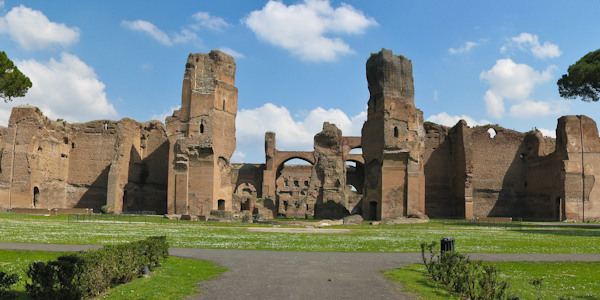
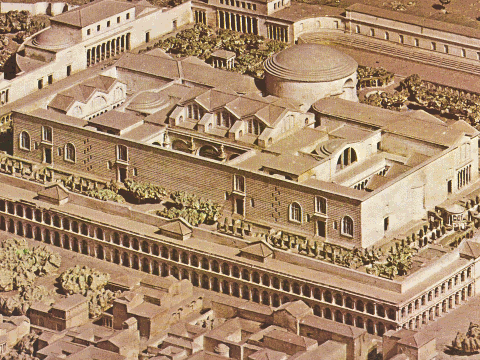
The largest surviving ruins of an ancient baths complex in Rome, the Thermae di Caracalla are a crumbling complex of brick walls and broken archways with some remaining scraps of floor mosaics sprawling over 33 acres.
In their heyday (they were dedicated in AD 216), the the Baths of Caracalla were fed by a dedicated acquaduct and could accomodate a staggering 1,600 bathers at a time.
The main bulding alone was 228 meters (750 feet) long, 116 meters (380 feet) wide, and 38.5 meters (125 feet) high.
Like most grand baths, the Baths of Caracalla were about more than just swimming and bathing. It was basically an ancient Roman community center, with two palaetra (gyms), two libraries (one for Greek texts, one for Latin texts), and plenty of shops.
Just like in modern times, an ancient Roman bather would first hit the apodyterium (changing room) to leave their toga (and their slave to guard it; if you came slaveless, you could hire one on the spot).
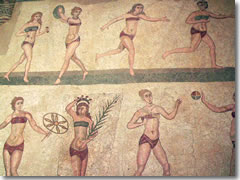
For men, this meant wrestling, boxing, running, fencing, or weight lifting for the men.
For women, a workout usually consisted of hoop rolling or ball throwing. Some lifted weights as well, but this activity was met with a shudder of impropriety by most ancient writers.
(Then again, those ancient writers were also often complaining that the official rules separating men and women at the baths were constantly being flouted or outright ignored; the fact that a succession of emporors kept re-issuing this ban over and over implies that the ancient chroniclers, through perhaps prudish, were right.)
After your workout, you would move on to the main event: the bathing.
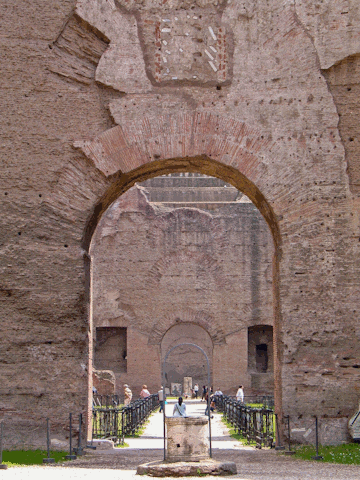
You would begin in the two-pooled tepidarium (the warm pool) to get warmed up and scrape off all the sweat and dirt.
First you'd oil up your body to loosen the dirt, then use a srtigil (a curved metal tool) to scrape the dirty oil off the skin. The better-off could hire a slave to do a more thorough job (the wealthy brought their own slaves).
During those periods of the Empire when it was fashionable to be hairless, you could go in for a bit of depiliation and hire a hair-plucker to make your skin smooth. Yes, this was for men and women alike. It also hurt. A lot. Especially when it came to the armpits.
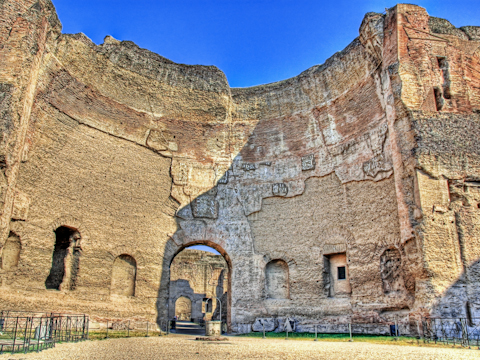
Skin gleaming and clean (and, possibly, hairless), it was time to head to the calidarium (hot pool), in which the waters and air were heated by a hypocaust system—the floor supported by a forest of tiny brick pillars around which air, scorched by wood and coal furnaces, could circulate. It then rose up hollow brick pillars to ceiling chimneys.
This was a combination sauna and hot tub to open up your pores and get a good sweat on.
The air temperature inside the calidarium could reach above 100º F (38º C) and 100% humidity. Your slaves could help cool you down as you sweated by pouring cold water over you from a patara dish.
The last stop was the frigidarium, a cold pluge pool to close up the pores and cool you down.
Notice in the public toilets the closely-spaced seats and lack of walls separating them into stalls. Also, the lack of separate men's and women's rooms. It was all open seating, and all together. (And, in lieu of toilet paper, you had a sponge on a stick.)
There are also the ruins of the natatio, an 80-meter (262-foot) outdoor pool that once had bronze mirrors to reflect the warmth of the sun down upon the swimmers.
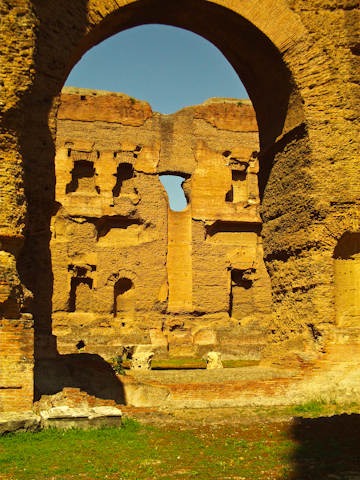
The baths were extremely popular, and remained in use until the sixth century—even the first few waves of barbarian invaders and rulers loved them.
The barbarians known as the Ostrogoths, though, not so much. They destroyed the hydraulics and heating systems, and the baths ceased to function in AD 537.
The complex was, as were most ancient structures, subsequently looted over the centuries—you've probably seen some of its sculptures without realizing they originally came from here, including the Belvedere Torso, now in the Vatican Museums, and the famous Farnese Bull and Farnese Hercules, both now in the Naples Archological Museum.
Later, the complex was mined for its very stones, which made excellent pre-cut building materials to help contruct medieval Rome. (The dozen granite columns that weighed 100 tons and once upheld the frigidarium now hold up the nave of Santa Maria in Trastevere church.)
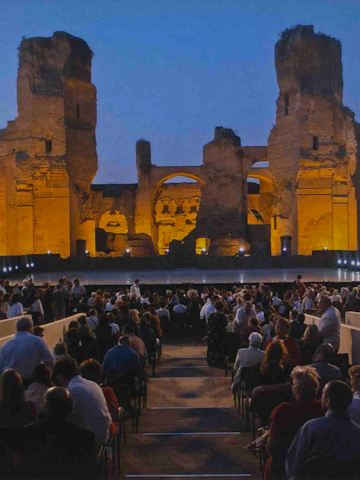
The baths have into use—though not as a bathing complex—in modern times, most surreally as the setting for the gymnastics portion of the 1960s Olympics Games.
Since then, they have become most famous as a spectacular setting for outdoor performances by Rome's Teatro dell'Opera company.
For decades they did Aïda out here, complete with thundering herds of horses and other animals during the parade scene, but by the 1990s that was deemed too rough on the ancient surfaces.
From 1994 to 2000, there were no performances here, but a comprise was found and there is now a stage set up on the grass with the baths serving as a backdrop instead of the stage.
The company rotates through a schedule of dramatic, crowd-pleasing operas (Norma, Atilla), ballets (Giselle), and concerts.
You can book opera and ballet tickets at the Baths of Caracalla most years though SelectItaly.com.
Viale delle Terme di Caracalla 52 (due south of the Colosseum and just southeast of the Circus Maximus and Palatine Hill, behind FAO)
tel. +39-06-571-7451 or +39-06-3996-7700
archeoroma.beniculturali.it
or
www.coopculture.it
Monday: 9am–2pm
Tuesday– Saturday: 9am–6:15pm
Last admission: 1 hr before closing
€6 (free first Sun of month)
Roma Pass: Yes (free, or 50% off)
Opera/ballet tickets: SelectItaly.com
Bus: 118, 628, 160, 714, 671, 717
Metro: Circo Massimo (B)
Hop-on/hop-off: Circo Massimo
Planning your day: Give yourself at least 45–60 minutes here—though 90 min. would be better.
Note that the last admission is one hour before closing.
Take a guided tour of the Baths of Caracalla with one of our partners:
The regular ticket covers entry to the Appian Way group (Baths of Caracalla, Tomb of Cecilia Metella, Villa of the Quintili) for €6 (you get seven days in which to visit them both).
I advise against the Archeologia Card,which you will also see offered. This card covers entry to the Appian Way sights plus the Downtown Ancient Rome group (Roman Forum, the Colosseum, and the Palatine Hill; normally €12) and the Museo Nazionale Romano group (Palazzo Massimo alle Terme, Palazzo Altemps, Baths of Diocletian, Crypta Balbi, Aula Ottagona; normally €7–€10).
Sounds good, right? Some major-league sights in there, yes? True: But the savings is actually only €2–€5—and you can get more bang for your sightseeing buck by using the Roma Pass instead to cover the Forum/Colosseum (plus something else major like the Galleria Borghese) and then get 50% (or €3) off the Appian Way sights as well. » more
Share this page
Search ReidsItaly.com
Viale delle Terme di Caracalla 52 (due south of the Colosseum and just southeast of the Circus Maximus and Palatine Hill, behind FAO)
tel. +39-06-571-7451 or +39-06-3996-7700
archeoroma.beniculturali.it
or
www.coopculture.it
Monday: 9am–2pm
Tuesday– Saturday: 9am–6:15pm
Last admission: 1 hr before closing
€6 (free first Sun of month)
Roma Pass: Yes (free, or 50% off)
Opera/ballet tickets: SelectItaly.com
Bus: 118, 628, 160, 714, 671, 717
Metro: Circo Massimo (B)
Hop-on/hop-off: Circo Massimo